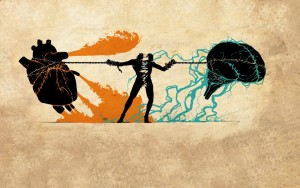What Lies in the Heart… and the Mind
Fitting human beings into ideal rational models is always pleasantly Newtonian, as it simplifies something that is so utterly complex, and gives us the occasional satisfaction that comes from thinking we know more than we actually do.
Behavioural finance was borne out of the stark realization that the markets followed rational and mathematical models as well as irrational and unpredictable occurrences in the anthropological spheres. No one would have ever suspected a deranged neuroscience student to walk into a movie theater to gun down innocent members of the audience on the opening night of Batman: The Dark Knight Rises – a bitter surprise so shocking that President Obama could only describe it as “beyond reason”.
But grim flashes from the past needn’t be the only empirical foundation for justifying the inclusion of behavioural psychology in financial analyses.
Years ago, scholars devised an experiment entitled the Ultimatum Game.
Two anonymous people would be offered $100. A coin toss would determine who would receive the full sum, under the condition that that same person would offer a portion of the ‘winnings’ to the other person. If the recipient thought the portion being offered was too small and rejected the offer, then neither would walk away with any money.
Consequently and rationally, ideal models attempting to predict the outcome would illustrate a donor offering as little as possible, and the recipient taking whatever came, since both were logical and selfish people.
It makes sense, doesn’t it? Having won the coin toss, I would like to keep as much as possible for myself. And having lost the coin toss, you’ll take whatever I give you, because something is better than nothing, right? So I’ll take $95.50, and you can keep the change!
Devourers of popular culture ‘science’ books may actually agree with my assertion, especially considering Richard Dawkins’ identification of the selfish gene. But the actual results from the experiment drastically contrasted with what had been initially projected.
About two thirds of American subjects offered between 40 and 50 percent to their respective recipients. Only about 4 percent of donors offered less than 20 percent to the persons on the other end of the coin toss. Most of the latter offers were rejected, consequently deteriorating the rational model.
These results, coupled with studies done on other populations around the world, led scientists to conclude that people were generally more concerned with fair outcomes rather than personal gain. Well, Mr. Dawkins, if the selfish gene really is at the center of our evolutionary process as biological beings, then it seems to be malfunctioning quite significantly!
To conclude, I’d like to pre-emptively answer a question that may arise after reading this brief post (“What am I supposed to do with this information?”)
Do whatever you like with this information.
Not every blog post needs to be a top 10 list for achieving personal bliss in today’s rambunctious world. In fact, it actually isn’t practical knowledge that sets us apart from other animals: monkeys are known to construct tools, ants build some of the most remarkable and intricate living spaces, and there are too many bloggers already telling us what to do and how to do it, and far too few showing us how to learn and think.
Some information is offered to coach. Other’s offered to educate.








